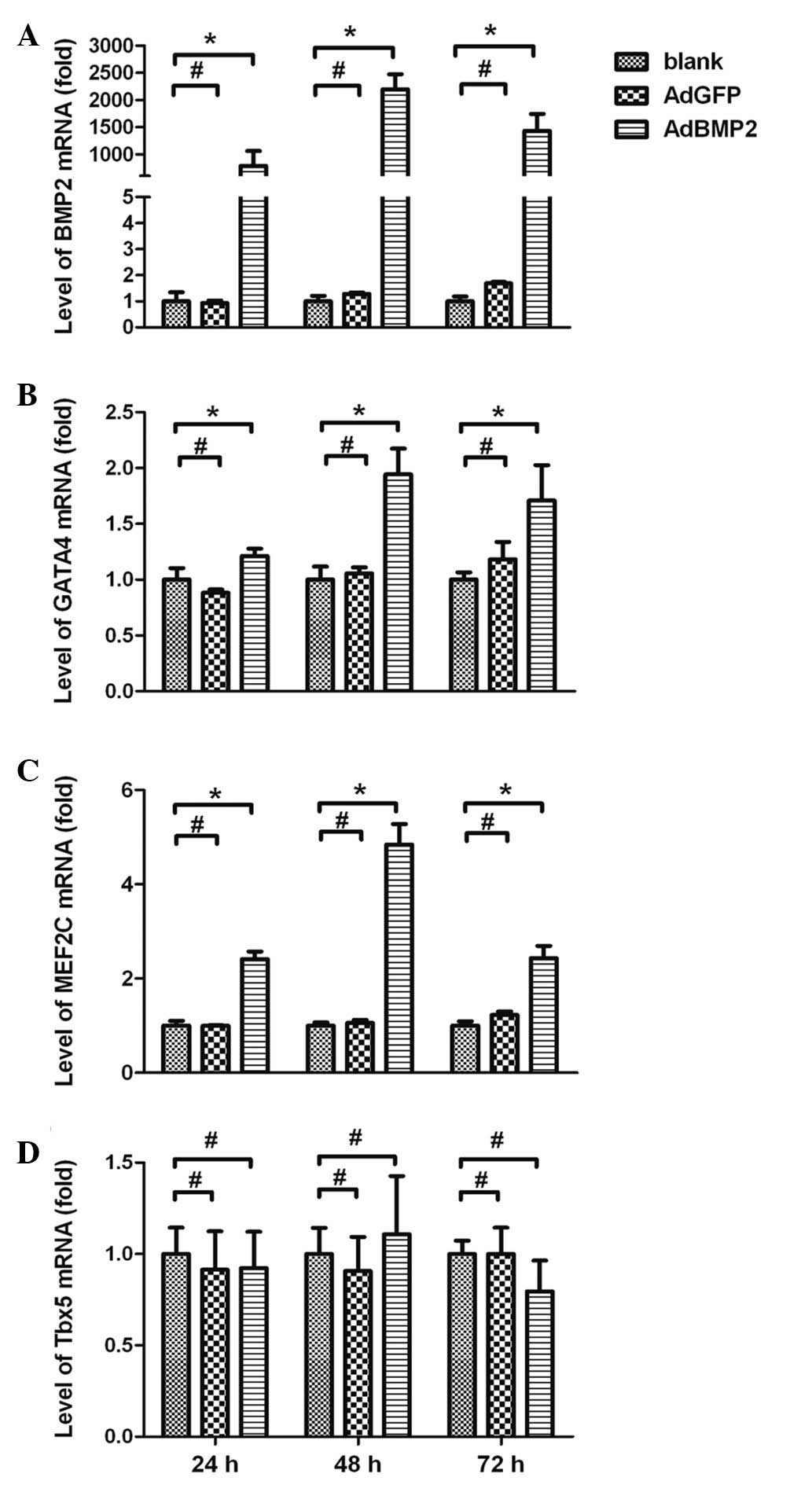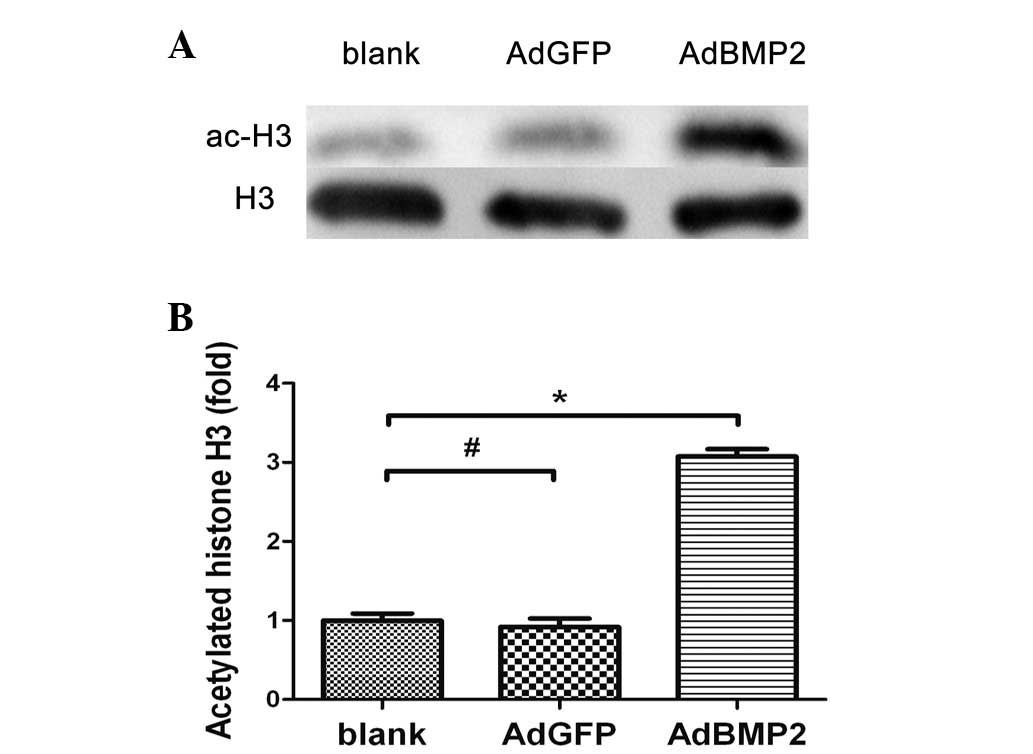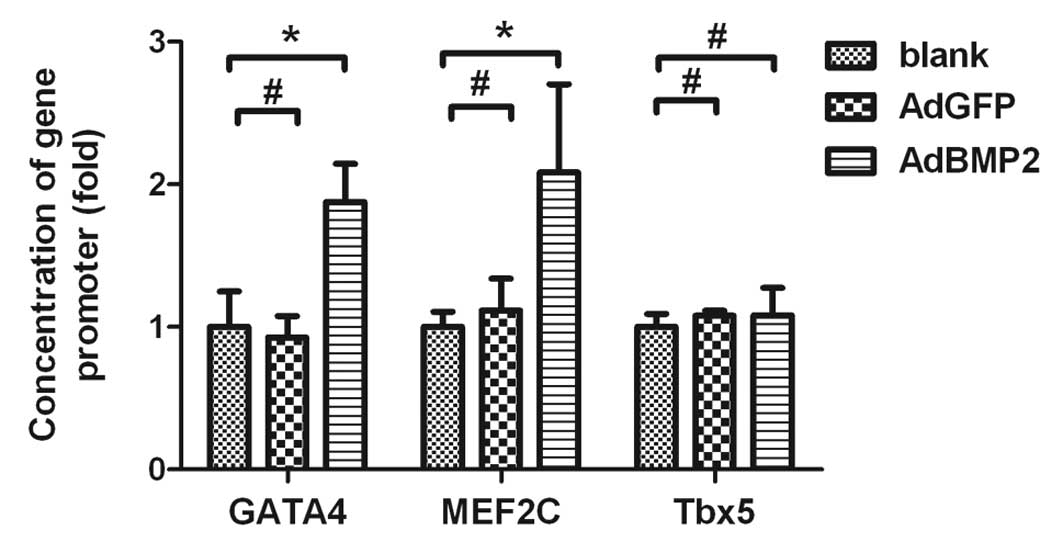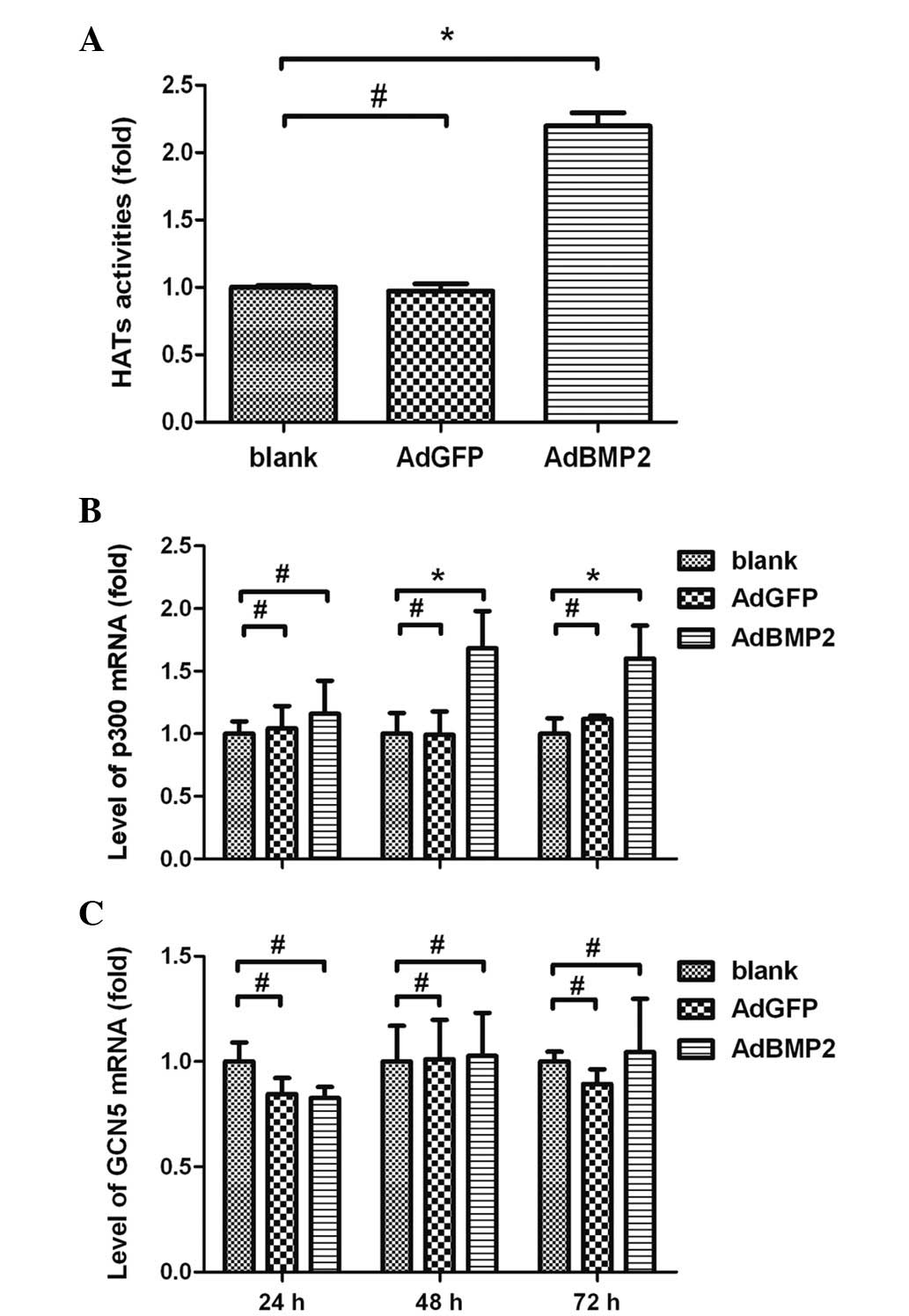Bone morphogenetic protein‑2 enhances the expression of cardiac transcription factors by increasing histone H3 acetylation in H9c2 cells
- Authors:
- Published online on: January 9, 2013 https://doi.org/10.3892/mmr.2013.1266
- Pages: 953-958
Abstract
Introduction
Numerous studies have shown that heart development is controlled by an evolutionarily-conserved network of transcription factors (NK2, MEF2, GATA, Tbx and Hand) that connect signaling pathways with genes for muscle growth, patterning and contractility (1–5). In this network, GATA4, MEF2C and Tbx5 are the most significant members which play critical roles in cardiac cell growth and heart development (6). The disturbance of temporal-spatial expression or mutations in these cardiac transcription factors may cause congenital heart disease (1,7). However, the upstream regulation of these genes remains unclear.
Previous studies have revealed that bone morphogenetic protein (BMP) signaling is required for cardiogenesis (8–10). It has been reported that several BMP subtypes, including BMP2, 4, 6 and 7, are expressed in the developing heart (9) and that BMP2 is a major transcription factor among several other members of the BMP family. BMP2 plays a significant role during cushion and valve morphogenesis and has a persistent expression in the cushion mesenchyme from 13.5 to 16 days post coitum (dpc). The expression of BMP2 is also observed in the valve tissues of adult mice (11). BMP2 knockout mice die at 7.5–10.5 dpc and have defects in the heart during development (12). Clinically, patients with a heterozygous deletion of BMP2 may present tachycardia as a result of an abnormal connection between the atria and ventricles (13). Several studies have demonstrated that BMP2 is able to elicit ectopic expression of the early cardiac markers, including Nkx2.5 and GATA4, but not of Tbx5 (9,14). Schlange et al(15) reported that BMP2 was expressed dynamically during cardiac morphogenesis and regulated the expression of other cardiac transcription factors, including Nkx2.5 and GATA4, at varying time periods. However, the molecular mechanisms by which BMP2 regulates the cardiac transcription factors remain largely unknown.
In recent years, histone acetylation/deacetylation has been at the center of attention with regard to the control of gene expression. Acetylation of the conserved lysine residues in histone tails by histone acetylases (HATs) stimulates gene expression by neutralizing positive charges, resulting in the ‘open’ state of chromatin, while histone deacetylases (HDACs) promote chromatin condensation, causing a repression of gene expression (16–18). It has been reported that histone acetylation plays a significant role during the development of the heart by acting as a switch for the regulation of gene expression (18). In our previous study, sodium valproate (NaVP), an inhibitor of HDACs, was identified as being able to increase the expression of CHF1, Tbx5 and MEF2C, causing cardiac abnormalities in fetal mice (19). Alcohol-induced overexpression of heart development-related genes was also identified as associated with the upregulation of histone H3 lysine 9 acetylation (20). One study in rat bone marrow mesenchymal stem cells also showed that suberoylanilide hydroxamic acid (SAHA), a HDAC inhibitor, upregulated the expression of Nkx2.5, GATA4 and MEF2C in a dose-dependent manner (21). These studies indicate that histone acetylation regulates the expression of cardiac-specific genes and is essential for heart development.
In the present study, the histone H3 acetylation levels in the promoter regions of the cardiac-specific genes and the HAT activities in the cultured H9c2 rat embryonic cardiac myocytes overexpressing BMP2 were determined. The results indicate that BMP2 is able to enhance the expression of the cardiac transcription factors GATA4 and MEF2C, in part by increasing histone H3 acetylation in the promoter regions of these genes. The HAT p300 subtype may play an essential role in BMP2-induced histone hyperacetylation.
Materials and methods
Reagents
The recombinant adenoviruses expressing human BMP2 (AdBMP2), the control adenoviruses expressing green fluorescent protein (AdGFP), the human embryonic kidney 293 cells and the H9c2 cells were kind gifts from the Molecular Oncology Laboratory at the University of Chicago Medical Center.
Preparation of adenoviruses in the 293 cells
AdBMP2 and AdGFP were transfected in the 293 cells to amplify the viruses. Propagations of the viruses were visualized by GFP expression under a fluorescence microscope. The viral supernatant was purified in phosphate-buffered saline (PBS) by ultracentrifugation and the titration of the viruses was measured by end point dilution assays. The prepared viruses were stored at −80°C for use.
Culture and treatment of the H9c2 cells
The H9c2 cells were grown in Dulbecco’s modified Eagle’s medium (DMEM)/high glucose (Thermo Scientific, Rochester, NY, USA) containing 10% fetal bovine serum (FBS; Hyclone, Logan, UT, USA) in humidified air (5% CO2) at 37°C. The cells were transfected with AdBMP2 or AdGFP at a varied multiplicity of infection (MOI). The transfection efficiency was measured by flow cytometry.
Real-time RT-PCR
The cultured H9c2 cells were collected 24, 48 or 72 h after transfection with AdBMP2 or AdGFP. The total RNA was extracted using a RNA extraction kit (Bioteck, Beijing, China). Single-stranded cDNA was reverse transcribed from 500–1,000 ng RNA using oligo(dT)-adaptor primers and AMV reverse transcriptase (Takara, Otsu, Japan) according to the manufacturer’s instructions. The cDNA was then amplified using gene-specific primers (Takara Biotechnology, Dalian, China) and a SYBR-Green Dye kit (Tiangen, Beijing, China). The mRNA expression levels of BMP2, GATA4, MEF2C, Tbx5, p300, GCN5 and β-actin were quantified by real-time RT-PCR using an IQcycler kit (Bio-Rad, Hercules, CA, USA). The annealing temperatures were 54°C for BMP2, 57°C for GATA4 and Tbx5 and 65°C for MEF2C, p300, GCN5 and β-actin. The gene-specific primers were designed using the Primer-3 software as follows: BMP2 forward, 5′-gacatccactccacaaacgaga-3′ and reverse, 5′-gtcattccaccccacatcact-3′; GATA4 forward, 5′-caactgccagactaccaccac-3′ and reverse, 5′-ccatggagcttc atgtagagg-3′; MEF2C forward, 5′-gcgaaagttcggattgatgaaga-3′ and reverse, 5′-gtggatgtcagtgctggcgta-3′; Tbx5 forward, 5′-cctgggtccgtaggtggaatag-3′ and reverse, 5′-ctttgatgctct gtctcgggtag-3′; p300 forward, 5′-agattcagagggcagcagagac-3′ and reverse, 5′-gccataggaggtgggttcatac-3′; GCN5 forward, 5′-ggaaaggagaagggcaaggag-3′ and reverse, 5′-gtcaatggggaa gcggataac-3′; β-actin forward, 5′-ggagattactgccctggctccta-3′ and reverse, 5′-gactcatcgtactcctgcttgctg-3′. The analyses of relative mRNA expression were carried out using the 2−ΔΔCt method as described previously (22). The values were normalized using β-actin as an endogenous housekeeping control gene.
Western blot analysis
The cultured H9c2 cells were collected 24 h after transfection with AdBMP2 or AdGFP. Nuclear proteins were extracted using a Nuclear and Cytoplasmic Protein Extraction kit (KeyGen, Nanjing, China) according to the manufacturer’s instructions. The nuclear proteins were separated and electrophoresed on 15% Bis-Tris polyacrylamide gels and then electrophoretically transferred to polyvinylidene difluoride (PVDF) membranes (Millipore, Billerica, MA, USA). The PVDF blots were then blocked with 5% nonfat milk in PBST (PBS plus 0.05% Tween-20) for 1 h. Subsequently, the blots were incubated with rabbit monoclonal antibodies for acetylated histone H3 (Ac-H3; Millipore, Temecula, CA, USA; 1:500 dilution) or for histone H3 (Millipore, Charlottesville, VA, USA; 1:500 dilution) in PBST containing 5% nonfat milk at 4°C overnight. HRP-conjugated goat anti-rabbit antibodies (Santa Cruz Biotechnology, Inc., Santa Cruz, CA, USA) were used as the secondary antibodies. The immunoreactive protein bands were detected with an Enhanced Chemiluminescence Luminal reagent (KeyGen), then scanned with a chemiluminescence kit (Gene, Hong Kong, China) and analyzed with Quantity One version 4.4 software (Bio-Rad). All western blotting experiments were repeated a minimum of 3 times.
HAT activity assay
The nuclear proteins were extracted as mentioned previously. The HAT activities of the nuclear protein extraction were determined using a HAT Activity Colorimetric Assay kit (BioVision, Mountain View, CA, USA) according to the manufacturer’s instructions. Nuclear proteins (40 μg) were prepared for each assay in 96-well plates at a concentration of 1 μg/μl, with 40 μl water prepared in one plate for the background reading. The assay mix was then added to each well and incubated at 37°C for 4 h. The samples were read by an enzyme micro-plate reader (Thermo Scientific) at a wavelength of 440 nm. Background readings were subtracted from the reading of all the samples. The HAT activities were expressed as relative OD values.
Chromatin immunoprecipitation (ChIP) assay
The cultured H9c2 cells were washed with PBS 48 h after treatment with AdBMP2 or AdGFP, then the cells were fixed with formaldehyde to cross link the proteins and DNA. ChIP experiments were performed using a ChIP assay kit (Millipore, Billerica, MA, USA). Subsequent to cross-linking, the DNA was cut into small fragments by sonication. The conditions used for the sonication to shear the DNA were 10 sec/time, with an interval of 80 sec for cooling. These steps were repeated 270 times. The protein-DNA complex was then recruited and precipitated by rabbit monoclonal antibodies for Ac-H3 (ChIP grade; Millipore). Anti-RNA polymerase was used as a positive control and normal mouse IgG was used as a negative control. The DNA from the samples was then obtained by phenol/chloroform extraction and ethanol precipitation. The promoter regions of GATA4, MEF2C and Tbx5 were assayed by real-time PCR of the total DNA using specific primers. The sequences of these primers were as follows: GATA4 forward, 5′-actgac gccgactccaaactaag-3′ and reverse, 5′-gtgtccctgttctccctgtagc-3′; MEF2C forward, 5′-ctttccaggttggctcttactcc-3′ and reverse, 5′-gcctcctcctaacaaagtgggta-3′; Tbx5 forward, 5′-actgac gccgactccaaactaag-3′ and reverse, 5′-gtgtccctgttctccctgtagc-3′. The annealing temperatures were 57°C for Tbx5 and 65°C for GATA4 and MEF2C. The analyses of the relative promoter precipitation levels were carried out using the 2−ΔΔCt method as described previously (22). The values were normalized using an input sample as the internal standard.
Statistical analysis
All experiments were repeated independently at least 3 times. All data are reported as mean ± SD and statistical analyses was performed using a one-way ANOVA. P<0.05 was considered to indicate a statistically significant difference.
Results
Expression of BMP2 in the H9c2 cells
To identify the expression of BMP2 in the H9c2 cells following transfection with AdBMP2, BMP2 mRNA levels were measured using real-time RT-PCR assays. The expression of the β-actin gene was used as an endogenous control. BMP2 was highly expressed in the AdBMP2-transfected cells, reaching a peak 48 h after the transfection (1,432±313-fold, AdBMP2 group vs. blank group, P<0.05). Extremely low expression levels of BMP2 were detected in the AdGFP and blank groups (Fig. 1A).
Expression of GATA4 and MEF2C in H9c2 cells overexpressing BMP2
The results of real-time RT-PCR assays showed that the mRNA expression levels of GATA4 and MEF2C were significantly enhanced in H9c2 cells overexpressing BMP2. As shown in Fig. 1B and C, GATA4 and MEF2C expression levels were enhanced by BMP2 and reached a peak 48 h after AdBMP2 transfection (1.94±0.23-fold for GATA4 and 4.84±0.43-fold for MEF2C, AdBMP2 vs. blank group, P<0.05). The expression levels of GATA4 and MEF2C in the AdGFP group were not altered (AdGFP vs. blank group, P>0.05). In addition, there was no significant change observed in the expression of Tbx5 in the cells following AdBMP2 transfection (AdBMP2 vs. blank group, P>0.05; Fig. 1D).
Increased histone H3 acetylation in the whole chromatin of H9c2 cells overexpressing BMP2
Using western blotting assays, the effect of BMP2 on histone H3 acetylation in H9c2 cells overexpressing BMP2 was analyzed. The ratio of Ac-H3 to H3 was determined in order to normalize the sample recovery and loading. As shown in Fig. 2, the histone H3 acetylation levels were significantly increased in H9c2 cells overexpressing BMP2 (3.07±0.16-fold, AdBMP2 vs. blank group, P<0.05). There was no significant difference in histone H3 acetylation levels between the AdGFP and blank groups (P>0.05).
Increased histone H3 acetylation in the promoter regions of GATA4 and MEF2C in H9c2 cells overexpressing BMP2
ChIP and real-time PCR assays were conducted to further investigate whether the upregulation of GATA4 and MEF2C by BMP2 was associated with changes in the histone H3 acetylation of these genes. The real-time PCR results showed that the quantities of promoter DNA for GATA4 and MEF2C were increased in H9c2 cells overexpressing BMP2 (1.88±0.27-fold for GATA4, 2.08±0.62-fold for MEF2C, AdBMP2 vs. blank group, P<0.05). There was no significant difference in these values between the AdGFP and blank groups (P>0.05; Fig. 3). Accordingly, the ChIP data indicated that the histone H3 acetylation levels in the promoter regions of GATA4 and MEF2C were significantly increased in H9c2 cells overexpressing BMP2. However, the histone H3 acetylation in the promoter region of Tbx5 was not significantly changed in the same cells overexpressing BMP2 (P>0.05). These data indicate that increased expression of GATA4 and MEF2C are associated with increased histone H3 acetylation in the promoter regions of these genes in H9c2 cells overexpressing BMP2.
Enhanced HAT activities and increased expression of HAT subtype p300 in H9c2 cells overexpressing BMP2
To further investigate whether the BMP2-induced histone H3 hyperacetylation was associated with HATs, experiments were performed using colorimetric assays to measure the HAT activities and to determine the expression levels of the HAT p300 subtype in H9c2 cells overexpressing BMP2. The results showed that HAT activities were significantly increased in H9c2 cells overexpressing BMP2 (2.20±0.17-fold, AdBMP2 vs. blank group, P<0.05). There were no significant differences in the HAT activities between the AdGFP and blank groups (P>0.05; Fig. 4A). The real-time RT-PCR data showed that the expression levels of p300 were significantly increased and reached a peak in the H9c2 cells 48 h after AdBMP2 transfection (1.68±0.30-fold, AdBMP2 group vs. blank group, P<0.05). There was no significant difference in the p300 expression levels between the AdGFP and blank groups (P>0.05; Fig. 4B). Moreover, the expression of GCN5 was not significantly altered in H9c2 cells overexpressing BMP2 (P>0.05; Fig. 4C).
Discussion
GATA4, MEF2C and Tbx5 are the most significant transcription factors during the early stage of heart development (6). In the present study, the expression levels of GATA4 and MEF2C, but not Tbx5, were identified as significantly enhanced in H9c2 cells overexpressing BMP2. These data are in agreement with the previous reports that BMP2 is able to induce GATA4 and MEF2C expression ectopically, resulting in an ectopic cardiac mesoderm specification in chicken embryos (9). These studies also observed that BMP2 was not able to affect the expression of Tbx5 in chicken embryos (9,14). Consistent with these studies, the results of the present study confirm that the expression of Tbx5 is not altered in H9c2 cells overexpressing BMP2.
Numerous studies have reported that BMP2 is required for heart development by inducing expression in various cardiac genes. However, the underlying mechanisms are largely unknown. One previous study in bovine granulosa cells suggested that BMP4 was able to suppress the expression of StAR by inhibiting histone H3 acetylation in the promoter regions of the gene (23). Pan et al(24) suggested that the activation of Sox9 gene transcription by BMP2 was associated with chromatin remodeling and histone modification in primary mouse embryo fibroblasts. In the present study, western blotting assays were performed to determine whether BMP2 was able to affect the histone H3 acetylation in H9c2 cells overexpressing BMP2. First an increase in the total amount of Ac-H3 in the whole chromatin extracted from H9c2 cells overexpressing BMP2 was identified. Further analysis of histone H3 acetylation in the promoter regions of the specific cardiac genes was then conducted. The results demonstrate that BMP2 is able to enhance histone H3 acetylation levels in the promoter regions of GATA4 and MEF2C. The increase of histone H3 acetylation levels in these genes is accompanied by an increase in the expression levels of these genes, suggesting that histone H3 acetylation may be one of the molecular mechanisms by which BMP2 upregulates the expression of GATA4 and MEF2C in H9c2 cells overexpressing BMP2. By contrast, no change in Tbx5 expression or in histone H3 acetylation in the Tbx5 gene promoter was observed in the same cells overexpressing BMP2.
The status of histone acetylation is determined by the balanced actions between the HATs and HDACs. In the present study, the colorimetric assay data show that BMP2 is able to enhance the HAT activities in H9c2 cells overexpressing BMP2. However, it is unclear which HAT subtype(s) participates in the regulation of histone H3 acetylation in response to BMP2 in the H9c2 cells. In our previous studies, p300 was identified with a higher expression level than other HAT subtype in crescent-shaped cardiogenic plates (25), and inhibition of p300 HAT activity resulted in reduced histone acetylation and decreased expression of GATA4 and MEF2C in mouse cardiac myocytes (26). Other studies also indicated a critical role for p300 in cardiac gene expression and heart development (27). In the present study, the data indicate that the expression level of p300 was significantly increased in H9c2 cells overexpressing BMP2, while another HAT subtype, GCN5, had no significant changes in the same cells overexpressing BMP2. This suggests that p300 is more important than GCN5, in BMP2-induced histone H3 hyperacetylation in the H9c2 cells.
In conclusion, the data demonstrate that BMP2 upregulates histone H3 acetylation levels in the promoter regions of specific cardiac genes, GATA4 and MEF2C. BMP2 also increases HAT activities and the expression of the HAT p300 subtype. The upregulatory effects of BMP2 on GATA4 and MEF2C are due, at least in part, to the increased acetylation levels of histone H3 in the promoter regions of these genes, which is associated with increased HAT activities and the expression of the HAT p300 subtype in the H9c2 cells.
Acknowledgements
The authors thank Professor Xupei Huang from Florida Atlantic University and Mr. Geoffrey Gatts from Ohio State University, USA, for their critical reading and editing of the manuscript. This study was supported by research grants from the Natural Science Foundation of China (Grant no. 81070132) and from the Natural Science Foundation of Chongqing (Grant no. CSTC2009BA5084).
References
|
Olson EN: Gene regulatory networks in the evolution and development of the heart. Science. 313:1922–1927. 2006. View Article : Google Scholar : PubMed/NCBI | |
|
Bryantsev AL and Cripps RM: Cardiac gene regulatory networks in Drosophila. Biochim Biophys Acta. 1789:343–353. 2009. View Article : Google Scholar : PubMed/NCBI | |
|
Black BL: Transcriptional pathways in second heart field development. Semin Cell Dev Biol. 18:67–76. 2007. View Article : Google Scholar : PubMed/NCBI | |
|
Satou Y and Satoh N: Gene regulatory networks for the development and evolution of the chordate heart. Genes Dev. 20:2634–2638. 2006. View Article : Google Scholar : PubMed/NCBI | |
|
Cripps RM and Olson EN: Control of cardiac development by an evolutionarily conserved transcriptional network. Dev Biol. 246:14–28. 2002. View Article : Google Scholar : PubMed/NCBI | |
|
Qian L, Huang Y, Spencer CI, Foley A, Vedantham V, Liu L, Conway SJ, Fu JD and Srivastava D: In vivo reprogramming of murine cardiac fibroblasts into induced cardiomyocytes. Nature. 485:593–598. 2012. View Article : Google Scholar : PubMed/NCBI | |
|
Brand T: Heart development: molecular insights into cardiac specification and early morphogenesis. Dev Biol. 258:1–19. 2003. View Article : Google Scholar : PubMed/NCBI | |
|
Song L, Yan W, Chen X, Deng CX, Wang Q and Jiao K: Myocardial smad4 is essential for cardiogenesis in mouse embryos. Circ Res. 101:277–285. 2007. View Article : Google Scholar : PubMed/NCBI | |
|
van Wijk B, Moorman AF and van den Hoff MJ: Role of bone morphogenetic proteins in cardiac differentiation. Cardiovasc Res. 74:244–255. 2007.PubMed/NCBI | |
|
Wang J, Greene SB and Martin JF: BMP signaling in congenital heart disease: new developments and future directions. Birth Defects Res A Clin Mol Teratol. 91:441–448. 2011. View Article : Google Scholar : PubMed/NCBI | |
|
Sugi Y, Yamamura H, Okagawa H and Markwald RR: Bone morphogenetic protein-2 can mediate myocardial regulation of atrioventricular cushion mesenchymal cell formation in mice. Dev Biol. 269:505–518. 2004. View Article : Google Scholar : PubMed/NCBI | |
|
Zhang H and Bradley A: Mice deficient for BMP2 are nonviable and have defects in amnion/chorion and cardiac development. Development. 122:2977–2986. 1996.PubMed/NCBI | |
|
Lalani SR, Thakuria JV, Cox GF, Wang X, Bi W, Bray MS, Shaw C, Cheung SW, Chinault AC, Boggs BA, Ou Z, Brundage EK, Lupski JR, Gentile J, Waisbren S, Pursley A, Ma L, Khajavi M, Zapata G, Friedman R, Kim JJ, Towbin JA, Stankiewicz P, Schnittger S, Hansmann I, Ai T, Sood S, Wehrens XH, Martin JF, Belmont JW and Potocki L: 20p12.3 microdeletion predisposes to Wolff-Parkinson-White syndrome with variable neurocognitive deficits. J Med Genet. 46:168–175. 2009. View Article : Google Scholar : PubMed/NCBI | |
|
Yamada M, Revelli JP, Eichele G, Barron M and Schwartz RJ: Expression of chick Tbx-2, Tbx-3, and Tbx-5 genes during early heart development: evidence for BMP2 induction of Tbx2. Dev Biol. 228:95–105. 2000. View Article : Google Scholar : PubMed/NCBI | |
|
Schlange T, Andrée B, Arnold HH and Brand T: BMP2 is required for early heart development during a distinct time period. Mech Dev. 91:259–270. 2000. View Article : Google Scholar : PubMed/NCBI | |
|
Jenuwein T and Allis CD: Translating the histone code. Science. 293:1074–1080. 2001. View Article : Google Scholar : PubMed/NCBI | |
|
Clayton AL, Hazzalin CA and Mahadevan LC: Enhanced histone acetylation and transcription: a dynamic perspective. Mol Cell. 23:289–296. 2006. View Article : Google Scholar : PubMed/NCBI | |
|
Backs J and Olson EN: Control of cardiac growth by histone acetylation/deacetylation. Circ Res. 98:15–24. 2006. View Article : Google Scholar : PubMed/NCBI | |
|
Wu G, Nan C, Rollo JC, Huang X and Tian J: Sodium valproate-induced congenital cardiac abnormalities in mice are associated with the inhibition of histone deacetylase. J Biomed Sci. 17:162010. View Article : Google Scholar : PubMed/NCBI | |
|
Zhong L, Zhu J, Lv T, Chen G, Sun H, Yang X, Huang X and Tian J: Ethanol and its metabolites induce histone lysine 9 acetylation and an alteration of the expression of heart development-related genes in cardiac progenitor cells. Cardiovasc Toxicol. 10:268–274. 2010. View Article : Google Scholar : PubMed/NCBI | |
|
Feng C, Zhu J, Zhao L, Lu T, Zhang W, Liu Z and Tian J: Suberoylanilide hydroxamic acid promotes cardiomyocyte differentiation of rat mesenchymal stem cells. Exp Cell Res. 315:3044–3051. 2009. View Article : Google Scholar : PubMed/NCBI | |
|
Livak KJ and Schmittgen TD: Analysis of relative gene expression data using real time quantitative PCR and the 2(−Delta Delta C(T)) Method. Methods. 25:402–408. 2001. | |
|
Yamashita H, Murayama C, Takasugi R, Miyamoto A and Shimizu T: BMP-4 suppresses progesterone production by inhibiting histone H3 acetylation of StAR in bovine granulosa cells in vitro. Mol Cell Biochem. 348:183–190. 2011. View Article : Google Scholar : PubMed/NCBI | |
|
Pan Q, Wu Y, Lin T, Yao H, Yang Z, Gao G, Song E and Shen H: Bone morphogenetic protein-2 induces chromatin remodeling and modification at the proximal promoter of Sox9 gene. Biochem Biophys Res Commun. 379:356–361. 2009. View Article : Google Scholar : PubMed/NCBI | |
|
Chen G, Zhu J, Lv T, Wu G, Sun H, Huang X and Tian J: Spatiotemporal expression of histone acetyltransferases, p300 and CBP, in developing embryonic hearts. J Biomed Sci. 16:242009. View Article : Google Scholar : PubMed/NCBI | |
|
Sun H, Yang X, Zhu J, Lv T, Chen Y, Chen G, Zhong L, Li Y, Huang X, Huang G and Tian J: Inhibition of p300-HAT results in a reduced histone acetylation and down-regulation of gene expression in cardiac myocytes. Life Sci. 87:707–714. 2010. View Article : Google Scholar : PubMed/NCBI | |
|
Shikama N, Lutz W, Kretzschmar R, Sauter N, Roth JF, Marino S, Wittwer J, Scheidweiler A and Eckner R: Essential function of p300 acetyltransferase activity in heart, lung and small intestine formation. EMBO J. 22:5175–5185. 2003. View Article : Google Scholar : PubMed/NCBI |













